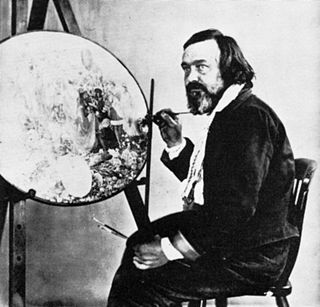
Richard Dadd was an English painter of the Victorian era, noted for his depictions of fairies and other supernatural subjects, Orientalist scenes, and enigmatic genre scenes, rendered with obsessively minuscule detail. Most of the works for which he is best known were created while he was a patient in Bethlem and Broadmoor hospitals.

The Pre-Raphaelite Brotherhood was a group of English painters, poets, and art critics, founded in 1848 by William Holman Hunt, John Everett Millais, Dante Gabriel Rossetti, William Michael Rossetti, James Collinson, Frederic George Stephens and Thomas Woolner who formed a seven-member "Brotherhood" partly modelled on the Nazarene movement. The Brotherhood was only ever a loose association and their principles were shared by other artists of the time, including Ford Madox Brown, Arthur Hughes and Marie Spartali Stillman. Later followers of the principles of the Brotherhood included Edward Burne-Jones, William Morris and John William Waterhouse.

Sir Edward Coley Burne-Jones, 1st Baronet, was an English painter and designer associated with the Pre-Raphaelite Brotherhood's style and subject matter.

Antiques Roadshow is a British television programme broadcast by the BBC in which antiques appraisers travel to various regions of the United Kingdom to appraise antiques brought in by local people. It has been running since 1979, based on a 1977 documentary programme.

Henry Holiday was an English Victorian painter of historical genre and landscapes, also a stained-glass designer, illustrator, and sculptor. He was influenced by the Pre-Raphaelite Brotherhood, many of whom he knew.
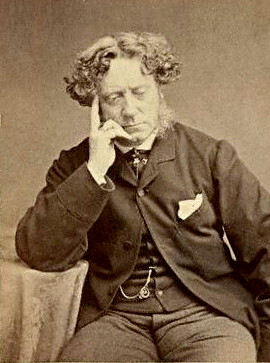
Sir Joseph Noel Paton was a Scottish artist, illustrator and sculptor. He was also a poet and had an interest in, and knowledge of, Scottish folklore and Celtic legends.

Simeon Solomon was a British painter associated with the Pre-Raphaelites who was noted for his depictions of Jewish life and same-sex desire. His career was cut short as a result of public scandal following his arrests and convictions for attempted sodomy in 1873 and 1874.
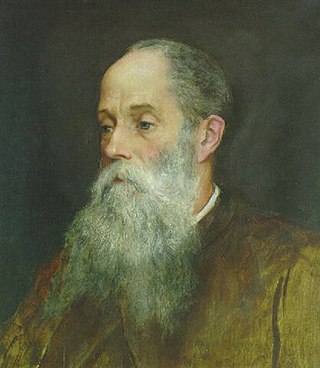
John Roddam Spencer Stanhope was an English artist associated with Edward Burne-Jones and George Frederic Watts and often regarded as a second-wave pre-Raphaelite. His work is also studied within the context of Aestheticism and British Symbolism. As a painter, Stanhope worked in oil, watercolor, fresco, tempera, and mixed media. His subject matter was mythological, allegorical, biblical, and contemporary. Stanhope was born in Cawthorne, near Barnsley, Yorkshire, England, and died in Florence, Italy. He was the uncle and teacher of the painter Evelyn De Morgan and encouraged then unknown local artist Abel Hold to exhibit at the Royal Academy, which he did 16 times.
Shaun Greenhalgh is a British artist and former art forger. Over a seventeen-year period, between 1989 and 2006, he produced a large number of forgeries. With the assistance of his brother and elderly parents, who fronted the sales side of the operation, he successfully sold his fakes internationally to museums, auction houses, and private buyers, accruing nearly £1 million.
Sidney Harold Meteyard RBSA was an English art teacher, painter and stained-glass designer. A member of the Birmingham Group, he worked in a late Pre-Raphaelite style heavily influenced by Edward Burne-Jones and the Arts and Crafts Movement.
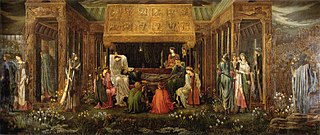
The Last Sleep of Arthur in Avalon is a painting by Edward Burne-Jones, started in 1881. The massive painting measures 279 cm × 650 cm, and is widely considered to be Burne-Jones's magnum opus.

The Star of Bethlehem is a painting in watercolour by Sir Edward Burne-Jones depicting the Adoration of the Magi with an angel holding the star of Bethlehem. It was commissioned by the Corporation of the City of Birmingham for its new Museum and Art Gallery in 1887, two years after Burne-Jones was elected Honorary President of the Royal Birmingham Society of Artists. At 101 ⅛ × 152 inches, The Star of Bethlehem was the largest watercolour of the 19th century. It was completed in 1890 and was first exhibited in 1891.

Sponsa de Libano is a painting by the Pre-Raphaelite artist Edward Burne-Jones dated 1891.
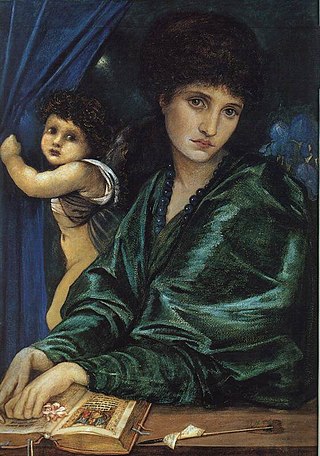
Maria Zambaco, born Marie Terpsithea Cassavetti, was a British artist's model of Greek descent, favoured by the Pre-Raphaelites. She was also a sculptor.

The Merciful Knight is a watercolour by the pre-Raphaelite artist Edward Burne-Jones which was completed in 1863 and is currently housed at the Birmingham Museum & Art Gallery.

The Flower Book by Edward Burne-Jones (1833–1898) is a series of 38 round watercolours, each about six inches across, painted from 1882 to 1898. The paintings do not depict flowers; rather, they were inspired by the flowers' names. Burne-Jones called them "a series of illustrations to the Names of Flowers". "Not a single flower itself appears", according to his wife Georgiana. They were painted for his private pleasure, many while he was resting at his summer home in Rottingdean, and were described by his wife as the "most soothing piece of work that he ever did". In 1905 Georgiana, by then a widow, published a limited edition of high-quality colour facsimiles.

The Nativity is one of a pair of monumental paintings by the Pre-Raphaelite artist Edward Burne-Jones commissioned for the chancel of the church of St John the Apostle, Torquay, England, in 1887. The Gothic Revival church was designed by architect George Edmund Street in the 1860s and decorated by Morris & Co., the decorative arts firm in which Burne-Jones was a partner.

Victorian painting refers to the distinctive styles of painting in the United Kingdom during the reign of Queen Victoria (1837–1901). Victoria's early reign was characterised by rapid industrial development and social and political change, which made the United Kingdom one of the most powerful and advanced nations in the world. Painting in the early years of her reign was dominated by the Royal Academy of Arts and by the theories of its first president, Joshua Reynolds. Reynolds and the academy were strongly influenced by the Italian Renaissance painter Raphael, and believed that it was the role of an artist to make the subject of their work appear as noble and idealised as possible. This had proved a successful approach for artists in the pre-industrial period, where the main subjects of artistic commissions were portraits of the nobility and military and historical scenes. By the time of Victoria's accession to the throne, this approach was coming to be seen as stale and outdated. The rise of the wealthy middle class had changed the art market, and a generation who had grown up in an industrial age believed in the importance of accuracy and attention to detail, and that the role of art was to reflect the world, not to idealise it.
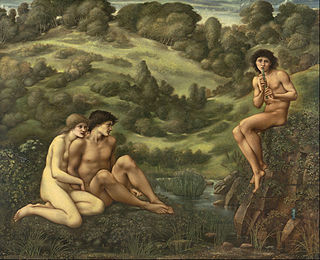
The Garden of Pan is a painting by the pre-Raphaelite artist Edward Burne-Jones which was completed around 1886 and is currently housed at the National Gallery of Victoria.

The Oceanids (The Naiads of the Sea) (French: Les Océanides (Les Naiades de la mer)) is a painting by Gustave Doré, dated to c. 1860. It depicts the Oceanids from Greek mythology with Prometheus chained to a rock in the background. The subject is from the ancient tragedy Prometheus Bound.

















